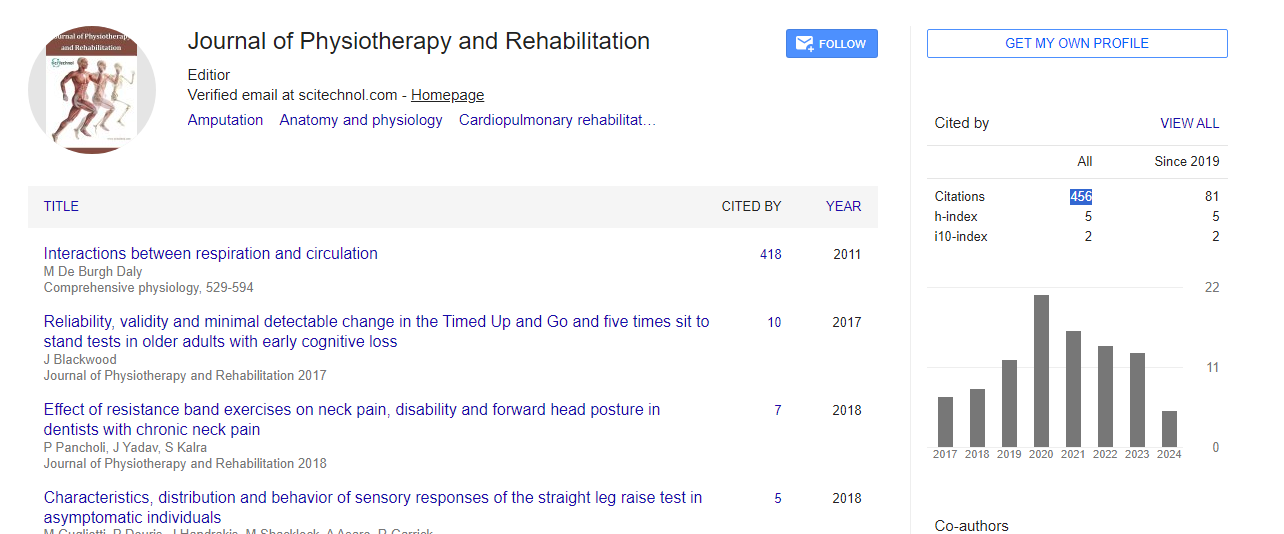Commentary, J Physiother Rehabi Vol: 8 Issue: 5
Evaluating Telerehabilitation as a Viable Alternative for Patients with Limited Mobility or Accessibility Issues
Dven Chen*
1Department of Rehabilitation, Adnan Menderes University Aydın, Turkey
*Corresponding Author: Dven Chen,
Department of Rehabilitation, Adnan
Menderes University Aydın, Turkey
E-mail: chen.dven@trresearch.org
Received date: 24 September, 2024, Manuscript No. JPTR-24-151641
Editor assigned date: 26 September, 2024, PreQC No. JPTR-24-151641 (PQ);
Reviewed date: 10 October, 2024, QC No. JPTR-24-151641
Revised date: 17 October, 2024, Manuscript No. JPTR-24-151641 (R);
Published date: 24 October, 2024, DOI: 10.4172/JPTR.1000185.
Citation: Chen D(2024) Evaluating Telerehabilitation as a Viable Alternative for Patients with Limited Mobility or Accessibility Issues. J Physiother Rehabi 8:5.
Description
Telerehabilitation has emerged as a promising solution for patients with limited mobility or accessibility issues, providing a means to receive essential rehabilitation services from the comfort of their homes. This approach advantages technology to deliver therapeutic interventions, assessments and ongoing support, overcoming geographical and physical barriers that often interrupts access to traditional rehabilitation services. Evaluating the effectiveness of telerehabilitation in enhancing patient outcomes is critical in understanding its role in modern healthcare, especially for individuals facing mobility challenges.
Limited mobility arise from various conditions, including neurological disorders, musculoskeletal injuries or age-related issues. For these patients, traveling to a rehabilitation facility can be physically taxing, if not impossible. Telerehabilitation offers a flexible alternative, allowing healthcare providers to deliver care through video consultations, mobile applications and remote monitoring devices. This approach not only increases accessibility but also enables timely interventions, which are important for effective rehabilitation. Research indicates that telerehabilitation can produce outcomes comparable to in-person therapy, particularly in musculoskeletal and neurological rehabilitation. For instance, studies have shown that patients receive telerehabilitation for stroke recovery experience similar improvements in function and mobility as those attending traditional therapy sessions. This immediate interaction can enhance motivation and accountability, which are vital components of successful rehabilitation.
Moreover, telerehabilitation can significantly reduce the logistical challenges faced by patients with limited mobility. By eliminating the need for travel, patients can allocate more time and energy to their rehabilitation exercises, potentially leading to better adherence to treatment plans. Additionally, telerehabilitation can accommodate patients’ schedules, making it easier for them to integrate therapy into their daily lives. This flexibility is especially beneficial for individuals with caregiving responsibilities or those managing multiple health conditions. Another advantage of telerehabilitation is its potential to encourage a sense of community and support among patients. Many individuals with limited mobility may feel isolated due to their conditions and telerehabilitation can help reduce this by connecting them with healthcare providers and peer support groups. Virtual group sessions allow patients to share experiences, challenges and successes, creating a supportive environment that encourages engagement and flexibility. This social aspect of telerehabilitation can improve mental health and overall well-being, which are important for successful recovery.
Despite the numerous benefits, several challenges must be addressed to optimize telerehabilitation for patients with limited mobility. One significant concern is the digital divide, not all patients have access to the necessary technology or reliable internet connections to participate in telehealth services. Additionally, regulatory and reimbursement policies need to evolve to support the widespread adoption of telerehabilitation, ensuring that patients can receive coverage for these services.
Conclusion
Telerehabilitation presents a viable alternative for patients with limited mobility or accessibility issues, offering a flexible, convenient and effective means of receiving rehabilitation services. By evaluating its effectiveness, healthcare providers can better understand how to integrate telerehabilitation into existing care models. As technology continues to advance and barriers to access are addressed, telerehabilitation has the potential to transform the landscape of rehabilitation, ensuring that all patients receive the support they need to recover.
 Spanish
Spanish  Chinese
Chinese  Russian
Russian  German
German  French
French  Japanese
Japanese  Portuguese
Portuguese  Hindi
Hindi 